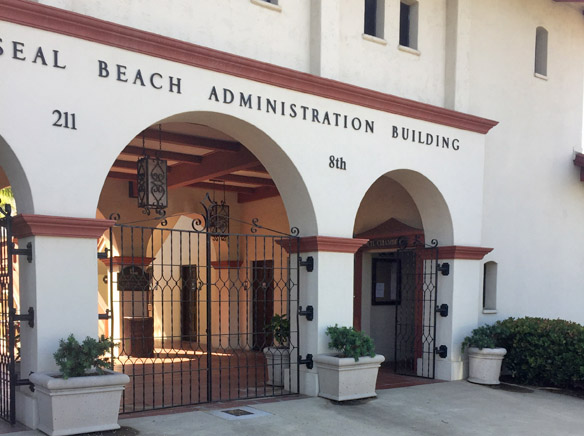Rep. Michelle Steel has been speaking with Congress members about funding local sand replenishment
Editor’s note: This article has been updated since the print edition was distributed.
The Seal Beach City Council is asking the U.S. Army Corps of Engineers to replenish the beach sand at Surfside and Sunset Beach. The council, at its Monday, April 26 meeting, unanimously approved a resolution asking the Corps of Engineers to fund the project and begin work immediately.
The council also authorized the city manager to take action to implement the project.
The most recent Army Corps sand replenishment project was supposed to be funded in 2018, but was delayed for lack of Federal money, according to the staff report by Deputy Public Works Director/City Engineer Iris Lee.
Sand erosion is a long-standing problem in Seal Beach.
“In 1962, Congress passed the Rivers and Harbors Act, which required the Army Corps to address these sand depletion impacts,” Lee wrote.
Danielle Stewart, communications director for Rep. Michelle Steel, provided additional background information after the Sun’s print edition hit newsracks.
“The central issue of shoreline protection in Orange County can be traced back to the 1940’s. Orange County’s beaches are eroding because of federal projects that permanently stopped natural sand flow on to our beaches,” Stewart wrote in an April 30 email.
“The US Army Corps of Engineers (USACE) created flood control projects along three local rivers and breakwaters were constructed to create and protect the Los Angeles/Long Beach harbor. Jetties installed by the USACE at Anaheim Bay harbor have permanently cut off sand supply to the natural shoreline,” Stewart wrote.
“The USACE and the federal government began repairing the issue by implanting the first of many repairs to the shore. This was done in increments with Stage 1 in 1964 as well as 8 more stages until 1990,” Stewart wrote.
“Then in 1995, after planning Stage 10, the USACE abandoned their responsibilities to Orange County and decided to abandon their responsibility for providing shoreline protection and declared this project was no longer considered ‘unique’ but simply just one of the many sand projects that fall under jurisdiction of the rest,” Stewart wrote.
“In 2000, the USACE stated that it was no longer budgeting for future stages. This left the communities along coastal Orange County at a high risk for flooding and major storm damage,” Stewart wrote.
“Historically this project had a continued partnership between the Federal Government, providing 67% of the financing with local communities providing the remaining 33%. The local cost share was always covered when it was time for a new ‘stage,’” she wrote.
“Local communities have held up their end of the bargain yet have been left abandoned by the lack of required federal funding. With the lack of action by the Federal Government, coastal Orange County is susceptible to dangerous environmental impacts that threaten the safety of people, wildlife, and local economy. In July 2020, Newport Beach saw strong ocean waves overpower the coastline and flood surrounding areas including neighborhoods and automobiles,” Stewart wrote.
The first beach sand nourishment project took place in 1964. That project put 1.5 million cubic yards of sand on Surfside beach, according to Lee’s report. That project was called Stage 1. The 2018 project is Stage 13.
“To date, the Army Corps has not been able to fund Stage 13 and is uncertain of possible funding in the near future,” Lee wrote.
“The coastline along Anaheim Bay Harbor and Newport Bay has experienced notable degradation since Stage 12 [the year 2010], where Surfside Colony residences, areas of the beach, boardwalks, parking lots, and other coastal assets are believed to be threatened by storms and high tides,” Lee wrote.
“The proposed resolution will draw attention to the eroded coastline and highlight the importance of sand nourishment to the Army Corps and the Federal Government. Failure to act immediately could result in property damage and pose a public safety concern if flooding occurs,” Lee wrote.
“Similar support resolutions and letters will be adopted by the project stakeholders, including the County of Orange, Department of Boating and Waterways, City of Newport Beach, City of Huntington Beach, and the Surfside Stormwater Protection District,” Lee wrote.
During the council meeting, District One Councilman/Mayor Joe Kalmick said Congresswoman Michelle Steel was working on getting funding for the sand replenishment project.
On April 30, Danielle Stewart, Rep. Steel’s communications director, wrote: “Rep. Steel is working with the coastal cities (Huntington Beach, Seal Beach, Surfside Storm District, Newport Beach) on long-delayed coastal mitigation for our eroding beaches. This is a top priority for the Congresswoman, especially as Congress begins debating funding for Fiscal Year 2022. In Congress, she has met with top Appropriations Committee leaders to explain the issue’s importance to our district and request that the already authorized project receive funding for the next fiscal year. She has had multiple conversations with Members directly involved in the funding process, with more to come in the next few weeks.
“Rep. Steel and her staff remain in contact with leaders from these cities to update them on the project. They have also met with the LA Army Corps District and HQ to discuss updates and share this project’s urgency.”





